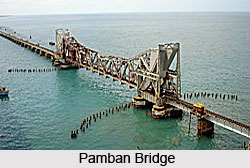 Pamban Bridge is a beam bridge on the Palk Strait which connects the town of Rameswaram on Pamban Island to mainland Indian Territory. Pamban Bridge refers to both the road bridge and the railway bridge.
Pamban Bridge is a beam bridge on the Palk Strait which connects the town of Rameswaram on Pamban Island to mainland Indian Territory. Pamban Bridge refers to both the road bridge and the railway bridge.
Pamban Bridge stretches two kilometres-strait between mainland India and Pamban Island and is the only surface transport link between the two. The mainland end of the bridge is located at 9 degree 16 minutes 56.70 seconds north to 79 degree11 minutes 20.12 second east.
Pamban Bridge was constructed by the Indians over a hundred years ago. It is a modern marvel of engineering. The bridge formed Pamban Island"s only link with the Indian mainland. Thousands of Hindu pilgrims on pilgrimage to the holy Hindu shrine of Rameswaram cross the bridge every day.
Pamban Bridge was opened in 1914 built by the Indian engineers. Pamban Bridge was the first sea bridge in India. It was the longest sea bridge (Beam Bridge) in India till 2010. The rail bridge in Pamban is for the most part, a conventional bridge resting on concrete piers, but has a double leaf bascule section midway, which can be raised to let ships and barges pass through. On 24 February 2014, the Pamban Bridge marked its 100th anniversary.
The railway bridge of Pamban is 6,776 ft (2,065 m) long and was opened for traffic in 1914. The rail-road bridge is still-functioning as a double-leaf bascule bridge section that can be raised to let ships pass under the bridge.
The railway bridge historically carried metre-gauge trains on it, but Indian Railways upgraded the bridge to carry broad-gauge trains in a project that finished on August 12, 2007. Until recently, the two leaves of the bridge were opened manually using levers by workers.
About 10 ships, cargo carriers, coast guard ships, fishing vessels and oil tankers pass through the bridge every month. From the elevated two-lane road bridge, the adjoining Pamban islands and the parallel rail bridge can be viewed.
After completion of Pamban Bridge, the metre-gauge lines were laid by them from Mandapam up to Pamban Railway Station. From here the railway lines bifurcated into two directions. On one railway that runs towards Rameshwaram which is about 6.25 miles up and another branch line of 15 miles terminating at Dhanushkodi. The section was opened to traffic in 1914.
The noted boat mail ran on this track between 1915 and 1964 from Madras-Egmore up to Dhanushkodi, from where the passengers were ferried to Talaimannar in Ceylon (now called Sri Lanka).
The metre-gauge branch line from Pamban Junction to Dhanushkodi was abandoned after it was destroyed in the cyclone in 1964. The bridge was subsequently restored to working conditions under E. Sreedharan in just 46 days.



















